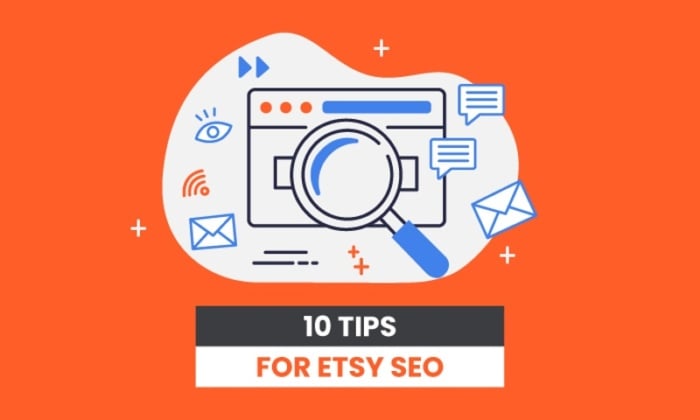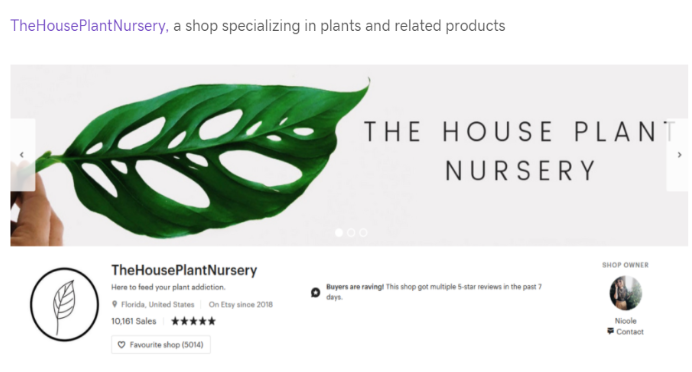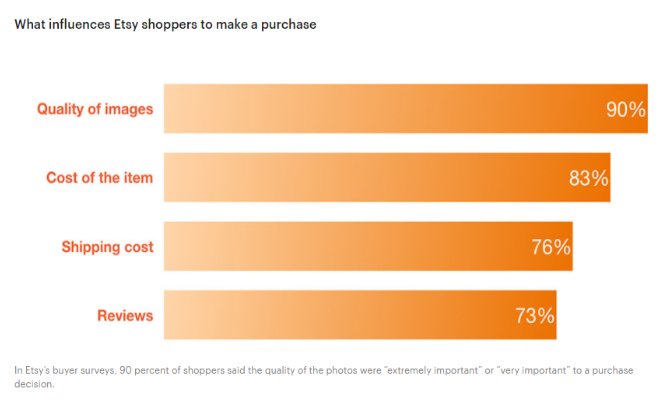10 Tips for Etsy SEO

With a reported 3.68 million active sellers on Etsy, it can be daunting to figure out how to ensure marketplace visibility.
How will new customers find your store with thousands of similar offerings? How do you ensure your products appear in a prime position on the search list?
The answer to these questions is simple: You need an Etsy SEO (search engine optimization) strategy.
Why You Need an SEO Strategy For Your Etsy Shop
Search engine optimization (SEO) refers to the practice of developing content, copy, visuals, and a slew of other factors tailored to increasing search visibility.
While the topic of SEO generally focuses on search engine results pages (SERPs), similar strategies can be employed by the savvy Etsy store owner to ensure products and store listing manifest at the top of the e-commerce site’s search function.
How Etsy Search Works
The Etsy search function is engineered to connect consumers with the products they’re looking for using two distinct factors: ranking and query matching.
Query matching refers to how effectively a potential consumer’s search term pairs with Etsy’s inventory listings. The search function parses attributes, categories, tags, and titles to match them with each searched term.
After query matching occurs, the search engine determines listing rank by aggregating eight definitive score features:
- Quality of Listing Score: This metric establishes how well a listing converts. This score increases when a consumer makes a purchase, resulting in a higher quality of listing score.
- Customer and Market Experience Score: All shops earn a score calculated using a combination of customer reviews, negative feedback, and the completion of the “about” portion of a shop’s description.
- Context-Specific Ranking (CSR) Technology Score: Artificial intelligence (AI) works to understand consumer interest and supply results to suit those needs. Essentially, this ranking studies past behavior to identify current desires.
- Relevancy Score: Exact-match keywords earn high rankings in the Etsy search hierarchy. If an exact match isn’t found, search spots are awarded to secondary keyword sources, including attributes, tags, titles, and categories aligning with the consumer’s query.
- Shipping Price Score: Etsy shops often charge a good amount for shipping. Stores that ship for free or for a discount earn higher shipping price scores than their more expensive counterparts.
- Recency Score: When an item is first posted, it gains a high recency score, which boosts the product for a short time after the initial listing.
- Translations and Language Score: Shop information should be conveyed in the language selected by the consumer when they established an Etsy account.
- Shoppers’ Habits Score: Much like the CSR technology score, this metric draws on past behavior to determine the current likelihood of purchasing.
10 Tips for Etsy SEO
While these metrics may seem impossible to influence, there are strategies to raise your ranking in the Etsy search. By optimizing these 10 Etsy SEO areas, you could improve your overall store ranking, potentially gaining increased visibility and reach for your listings.
Be Thoughtful About Your Shop Name
Your store name becomes the title for your store page, which is visible in SERPs. When crafting this all-important shop title, ensure what you sell is clear to consumers.
If your name is too whimsical, for instance, consumers may bypass your products in search of better-defined pastures.
For example, Etsy seller The House Plant Nursery chose a name that clearly states what a consumer will encounter upon entering their shop.
This technique eliminates confusion and drives the consumer directly to their intended source.

Another consideration when choosing your shop name is its length. With character caps on usernames across social media platforms, from 15 on Twitter to 55 on Etsy and Facebook, it’s worth considering a short name that won’t get cut off by these sites.
Include High-Quality Photos
As the adage goes, a picture is worth a thousand words. When it comes to Etsy photographs, it’s arguable that a picture is worth infinitely more.
As an online-only platform, photos need to attract attention, maintain attention, and convert consumers.
According to Etsy, product photos are the deciding factor for purchasing a shop, outweighing price, the cost to ship, and customer reviews.

Etsy allows sellers to add up to ten photos per item, so choose your images wisely. As more users are drawn to pictures, your overall ranking may increase.
Select Etsy SEO Keywords Carefully
Keywords are the foundation of improving Etsy SEO. Etsy prefers to highlight shops that include direct matches with shoppers’ keywords.
To uncover the best keywords for your shop, think like a buyer.
What would your target customer search for? Which terms would they be most likely to key into the search bar?
After identifying keywords by embodying your target consumer, explore direct competitors’ keywords to ensure all relevant terms have been gathered.
While organic research is a great starting place, using an SEO tool like Ubersuggest helps with in-depth keyword data and provides metrics on backlinks, content ideas, and additional keyword suggestions.
Use keywords in tags, titles, categories, and attributes for a robust Etsy SEO strategy to more effectively match your listings with consumer queries, which could potentially result in increased visibility.
However, don’t overdo it on keywords by jamming titles full of them or other keyword stuffing methods. Etsy is actively working to reduce the visibility of titles stuffed with keywords.
Optimize Your Shop Sections
Shop sections structure products into explorable groups. Potential sections include groupings by size, type, color, etc. These sections appear as links on the left sidebar of the shop.
In addition to aiding overall shop organization, sections can help improve your Etsy SEO.
Each section functions as an independent location, complete with a unique landing page and title derived from the section name. These individual landing pages supply more opportunities to use your keywords.
Consider using section titles that double down on keywords, again improving shop organization and the likelihood of appearing early in searches.
Use All Available Tags and Optimize Them
You can have 13 tags in item descriptions. Use this opportunity to make the most of your keywords.
Each tag has space for 20 characters, so focus on long-tail keywords and think beyond your existing keywords.
Etsy encourages using regional phrases, synonyms, and multi-word phrases when building out tags. However, the platform discourages repetitive tagging, intentional misspellings, multiple languages, and pluralizing keywords.
By optimizing these tags, you can better identify your product, allowing your consumer to find your shop more easily, which can improve your Etsy SEO.
Update Your Listings Often
When you renew existing Etsy listings, they receive a small boost in the site’s search rankings.
Although this practice isn’t a long-term Etsy SEO solution, it can increase search visibility for more competitive keywords.
By giving your listing an extra boost in periods of high consumer activity (e.g., holidays), you could increase the number of consumers who see your listings.
Gain Backlinks
Backlinks, or inbound links, are links to your store or products from external sites. These are vital to Etsy SEO strategy as they increase search engine confidence in a site.
You can earn backlinks, even if you’re not a well-known brand using these three strategies:
- Build Your Blog: Blogs can expand your audience, increase your SEO score, build your presence as an industry leader, and help you score quality backlinks. By creating unique, valuable content, others may link to your shop or specific products.
- Get Social: When sharing links to your blog and shop on Instagram, Twitter, Pinterest, and other social media channels, you increase the likelihood of reaching new consumers who may backlink to your shop.
- Reach Out: Identify mediums that would likely feature your shop or your products. These outlets can include blogs, publications, and Instagram accounts. After making this list, start reaching out. Incentivize these individuals to link to your site by offering them a discount or a sample item.
Create a Seamless Customer Experience
Etsy wants consumers to have an enjoyable shopping experience, which is why the customer and experience score is incorporated into the organization’s search algorithm.
If shops adhere to Etsy’s policies and have a strong customer service record, they can receive a boost in Etsy SEO.
To help this factor improve your Etsy SEO, complete all sections within your store, paying particular attention to payment, shipping, about, privacy, and returns and exchanges.
Be sure to answer customer service messages quickly and resolve any negative feedback.
Run Etsy Ads for Your Shop
While word-of-mouth advertising could get you far, running Etsy ads may help get you the rest of the way—while conveniently boosting your Etsy SEO.
Use paid advertising to increase your search reach. When you opt to feature an item as a Promoted Listing, you pay per click for the item to maintain top position in the search results.

After increasing visibility and sales through Promoted Listings, start asking for reviews to improve your customer and market experience score and your overall Etsy SEO.
Conclusion
If there’s one take away from this blog, it’s the importance of visibility on Etsy. With your store set up and ready to sell, it’s time to give your products the best chance to be found.
As you begin to build your marketing strategy, enact the above methods to increase your Etsy SEO.
As you optimize your shop and your listings, your search visibility should grow, attracting new consumers and extending your reach across the platform.
What’s the most effective Etsy SEO strategy you’ve used?
The post 10 Tips for Etsy SEO appeared first on Neil Patel.
from Neil Patel https://ift.tt/3sWfrMw
No comments